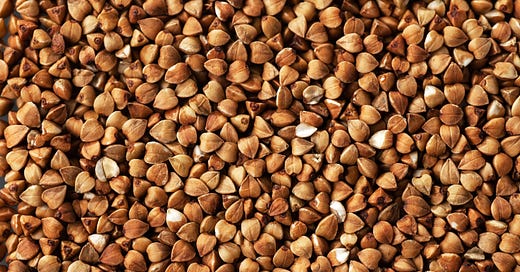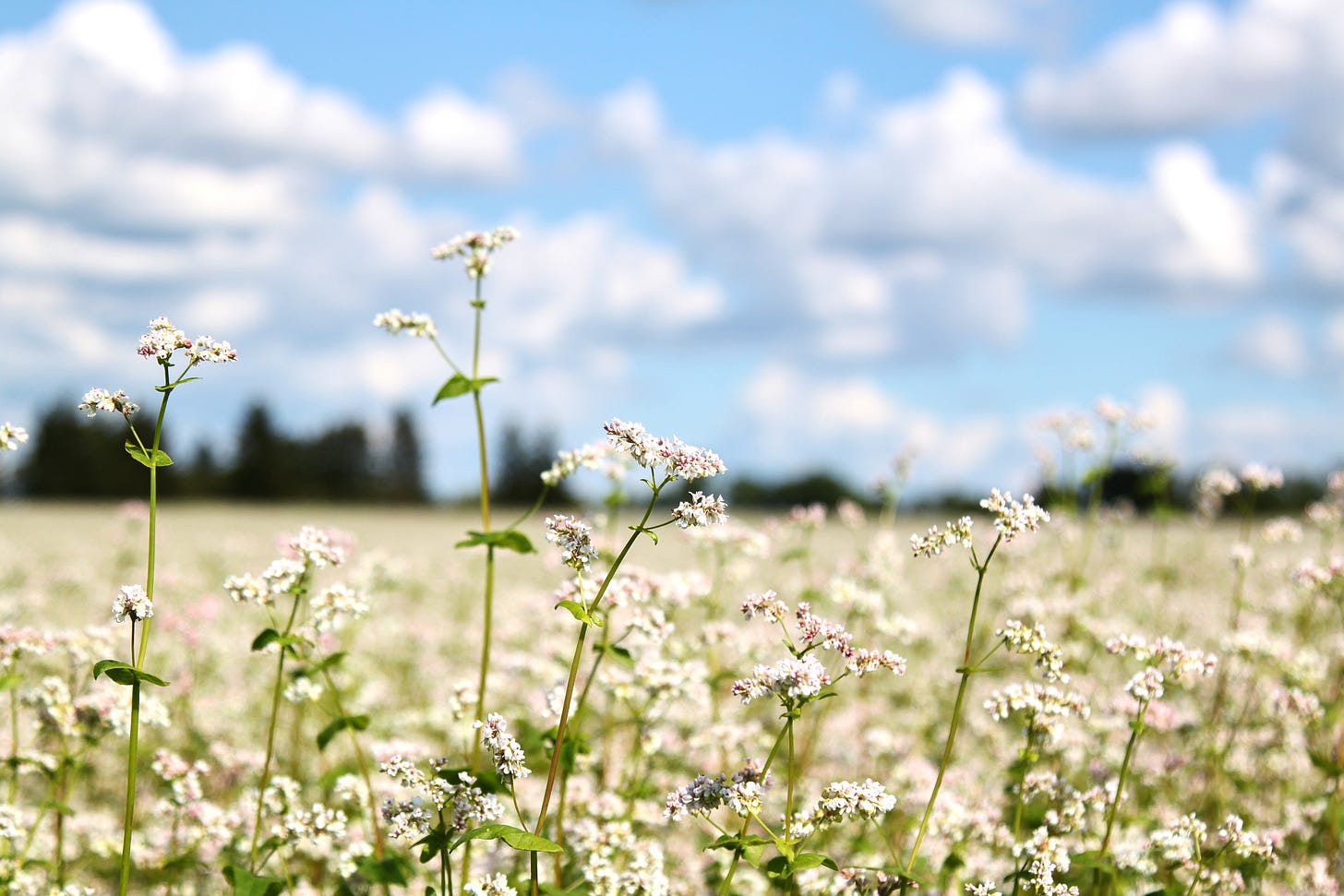Dream with me for a moment: You’re flipping through a cookbook on regenerative baking, and you see a section spotlighting a bunch of ingredients. You focus on an entry about buckwheat. Hm. What makes it good for the world? And how do you bake with it? Those are the questions behind this series. Stay tuned for upcoming spotlights on aquafaba and moringa.
My buckwheat baptism happened last year at lunch outside the Breizh Café in Paris. On my plate, a Brittany-style crêpe—called a galette since it’s made with buckwheat rather than wheat—hugged a steaming center of Comté, asparagus, and peas. Crisp and lace-edged, the galette tasted a little like hazelnut, its earthy flavor giving the vegetables an extra spring-time zing. It was a buckwheat coup de foudre: love at first bite.

Buckwheat isn’t wheat or even a grain, but a gluten-free seed. Dutch settlers in early America thought the pyramidal seeds resembled beechnuts and wheat (“boch” and “weit”), a perfectly reasonable thought that nevertheless kicked off centuries of botanical confusion. The pseudo-grain originated in Asia and spread across most of the Northern hemisphere thanks to its ability to grow even in poor conditions. (We should all be so lucky.) And as climate change accelerates, its adaptability may make it an increasingly important food.
The climate case for buckwheat
Buckwheat is an underdog compared to staple crops like wheat, maize, and rice, which together make up 40% of calories consumed worldwide. Wheat alone makes up a fifth of global daily calories, and is key to most of western baking. But it and other staple crops face increasing threats from climate impacts like drought, a food security risk that’s sending some researchers looking for hardier options.
A study published this year in the journal Agricultural Water Management found that buckwheat is one crop that can handle the drought conditions climate change will make more common. The research team behind the study found that both wheat and spelt (an ancestral relative of wheat) suffered under mild drought, while buckwheat withstood even extreme drought without breaking a sweat.
Xabier Simón Martínez de Goñi, a doctoral candidate at the University of the Basque Country who co-authored the study, told me by email the findings suggest “buckwheat may have a significant role to play as an alternative to conventional crops in the future.”
And that’s not only because it can take a dry spell in stride. Buckwheat adds biomass to depleted soils, feeds pollinators (and makes fabulous honey) during its long flowering period, and disrupts pest and disease cycles on farms. It’s not the only alternative crop we should grow and eat for a more resilient food system, but it’s a pretty tasty place to start.
Ideas for baking with buckwheat
Buckwheat’s can-grow attitude is visible in the breadth of cuisines it inhabits. See: Japanese soba noodles, the Eastern European porridge kasha, and my favorite galettes from the Brittany region of France. It even had a foothold in early American recipes like griddle cakes, before the food system industrialized and anointed wheat, corn, and soy as our kingpin ingredients.
One of my favorite ways to use buckwheat is also one of the most ubiquitous across food cultures: in a thin pancake like Russian blini, Indian kuttu ki roti, or French galettes (which I’ll share a recipe for later this summer). Buckwheat makes sense in a vertically ambivalent pancake because its lack of gluten means it doesn’t lend a baked good much structure or rise. It does however lend a distinct, toasty-earthy flavor that goes well with chocolate, nuts, and springy fruits.
But buckwheat can also makes great cookies and cakes, with a structural assist from baking powder or a 50/50 blend of buckwheat and (gluten-containing) all-purpose flours. The latter is Roxana Jullapat’s recommendation in Mother Grains, a cookbook that’s my vote to replace bibles in hotel room nightstands. Alongside other chapters on grains that grow in the US, her chapter of buckwheat recipes includes a chocolate cake that made me permanently team bucklate (chocwheat?). In France, recipes often go full buckwheat or use a blend of almond and buckwheat flours, as I learned in the cookbook Sarrasin by Breizh Café owner Bertrand Larcher. Next week I’ll send a cookie recipe he was kind enough to share with us that puts buckwheat’s toasty flavor on sweet display.
More on buckwheat
Read about buckwheat’s tentative resurgence in the US (Modern Farmer)
Then listen to my podcast episode for more on the grains—including buckwheat—that we should bake with in the climate era
If you’re ever in Paris, hit up the chocolate ship Ursa Major for their weep-worthy solar system chocolates (the little bitty earth is buckwheat)
Barring international travel, look to the cookbook Mother Grains for inspo, or Sarrasin if you read French (the buckwheat crème brulée is singing me a siren song; the cookie is coming your way next week)
What buckwheat recipes do you love to bake with? Leave a comment!
Special thanks to Xabier Simón Martínez de Goñi for corresponding with me for this newsletter.








Love buckwheat. My favorite granola alt is Lil Bucks, which are made with organic buckwheat. So delish!